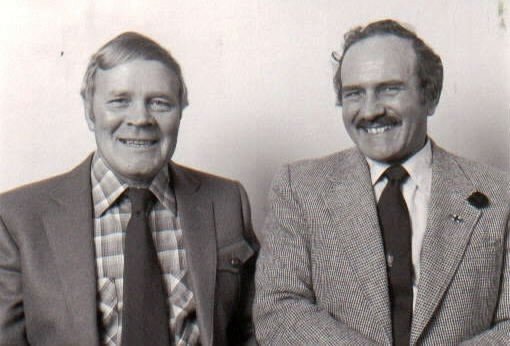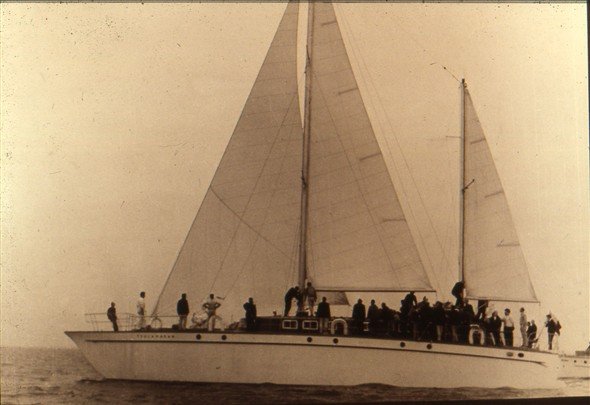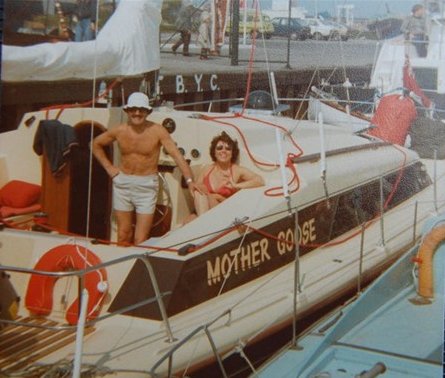1 - The Prout Story
From the Bulletin 1980
From Fred McCave’s Canvey Pioneers series………………….
Thanks to the genius of a Canvey family the name of Canvey has became world-famous. Their products have been sailed all over the oceans. Their history goes back 45 years to small beginnings.

Advert for the Prout Folding Dinghies and Canoes
The firm of G. Prout & Sons Ltd. was a partnership started by Mr. Geoffrey Prout and his two sons, Roland and Francis in 1935, Mr. Geoffrey Prout was a keen yachtsman and author of boys books and yachting handbooks who felt that a folding dinghy was needed which was light and could easily be stored aboard small yachts. A type of fold flat dinghy was invented and tried out and found to be suitable. This boat which was first tried out on a duck pond was the forerunner of a series of dinghies and small folding sailing boats and canoes which became well known throughout the world.
The war intervened and the family all joined the forces and boatbuilding was temporarily shelved. After the war, the brothers Roland and Francis and their father and mother started again in the factory at Smallgains Corner. From then on the firm grew and hundreds of folding dinghies and canoes were sold all over the world.

Roland and Francis Prout
In 1949 Roland and Francis started experiment by lashing two canoes together to make the first catamaran. The idea of developing a catamaran had been in their minds for some time, Roland and Francis were at this time doing serious canoe racing and were the British Champions in K2 Kayaks. They also represented Britain in the 1952 Olympics and spent two weeks pre-Olympic training in Sweden with the Swedish canoe team. They then carried out a more serious catamaran experiment by trying two Kl racing kayaks together with a bamboo platform and rigging this craft with a mast and sails (the main sail was a small lug sail and the jib from a 14ft. International dinghy). This latter experiment was so successful and promising that the brothers decided to design and make a serious catamaran, which when built was called “Shearwater”. This catamaran, which was eventually known as “Shearwater 1”, was raced locally and won every race it entered. She was also entered in the ‘D’ Class handicap in the Burnham-on-Crouch annual regatta week in 1954 and won this outright.

The 77ft “Tsulamaran” luxury cruiser
The cat was noticed by many well known dinghy yachtsmen of the day including the Hornet King Beecher Moore and the dinghy sailor Ken Pearce. The result was that the Prouts developed a new design which was called the “Shearwater II” and the catamaran “Endeavour” was built for Ken Pearce from the “Shearwater II” hull mould. “Endeavour”, in her first seasons sailing won the fastest boat trials at Cowes, Isle of Wight in 1955 and clocked a speed of some 16kn. This catamaran was also, timed over a short distance at 22kn. and created quite a sensation in Cowes at that time. The Prout brothers in the meantime raced the similar Shearwater in regattas and won many races. They finally won the fastest boat trials in Southampton Water in the same year which was run by the Western Bay Yacht Club.Interest in catamarans was generated by these events and many people wanted a chance to own one.
Meetings were held which included the cat designer Bill O’Brien and the result was that the Prout brothers designed the smaller, more easily trailed “Shearwater III” and Bill O’Brien designed the hard chine “Jumpahead”. Roland and Francis entered the No. 1 Shearwater III in the first Cross Channel dinghy race from Folkstone to Boulogne in 1956 and beat all the best racing dinghy helmsmen of the day (which included the famous Uffa Fox) by over one hour. Ken Pearce, in the 18ft catamaran “Endeavour” also entered this race and was first boat home on the beach at Boulogne, with the Prout 16ft 6ins Shearwater III about 10 minutes behind. The Shearwater III won the event on handicap and this win created so much publicity for the boat that the success of the Shearwater III was assured from then on.

Advert for Shearwater III
In the years that followed over 2,000 of these boats were built and over 1,500 of them at the Prout factory at Canvey. The Shearwater III was the world’s first production catamaran. In 1957 the firm moved to larger, new premises at the Point, Canvey, where they are to this day.
The Shearwater III became a strong and successful racing class in Britain with fleets actively sailing all over the British Isles. It finally achieved Royal Yachting Association recognition by being made a National Class, which is still active and strong today. About 50 of the best Shearwaters meet every year to do battle for the National Shearwater Championships, a coveted prize and a hard weeks racing.
It is from the Shearwater that most of the future catamaran designs have come. The round hull sections have been copied successfully all over the world, till finally was developed the Tornado Olympic Class which is probably the fastest two man racing boat in the world today.
Notwithstanding all the recent development in catamaran design, the Shearwater III can still hold its own with the best, and length for length is as fast and as good a performer as any design produced since 1955 when she made her first debut.
The Prout Brothers have in the meantime carried on designing and producing other designs, mostly in the larger cruiser class. Some of the designs produced since the Shearwater are:-
The Cougar, 19ft two man catamaran, successful in the U.S.A.
The 19ft small cruiser, 27ft and 31ft. Ranger Class cruisers.
Then came the 45ft Ocean Ranger, various 35 and 37ft cruisers, such as the “Taranga” Class.
The Princess Catherine 36ft cat, and the 77ft “Tsulamaran” luxury cruiser, were all built and sold at this time.
Another period of successful Prout Brothers designs were the range of workboats from 27 – 45ft long. These powered boats were used for research and various works all over the world. Some were powered to do speeds of up to 25kn and to cope with the roughest working conditions. They have been purchased by oil companies. Government Departments, seismographic survey work in Africa, Egypt and Pakistan.
The Prout Brothers also designed and produced a small 14ft powered catamaran outboard sportsboat called the “Panther” in which they competed and won the Havoline Production Outboard Trophy at Ruislip Lido in 1962. A hundred or so of these boats were produced and one raced and completed the Paris Six-Hour race in the Seine when no catamaran had ever competed in this race. The boat came in about 16th out of an entry of over one hundred in a gruelling race with the world’s top outboard racing boats. Since then outboard catamarans have dominated this event and almost any other big outboard event where there is hard, rough water racing.
Perhaps the most successful of the Prout brothers designs are the latest range now in production. These boats being bought and sailed all over the world have done a great deal to finally overcome the prejudice which has been ever present against all multihulls over the years. It is true to say that only in recent years has the catamaran been recognised as an established and respectable type to take its place alongside the traditional boat designs. The brothers were both granted the Freedom of the City of London and made Liverymen of the Worshipful Company of Shipwrights.

Francis and Erica Prout in their ‘Snowgoose 37 ‘ called Mother Goose
In 1975 a new company was formed with a board of directors composed of Roland and Francis Prout, John and Tom Lawrence, Rodney Hall and Robert Underwood. This brought Robert Underwood and Rodney Hall together in active partnership with the Prout Brothers. The company was to be known as Prout Catamarans and Robert Underwood was appointed managing director. The new company was licenced by the Prouts to manufacture, promote and sell the Prout catamarans, starting with the newly designed Quest 31. This arrangement allowed the Prout brothers more time to concentrate on design and there soon followed the new Snowgoose 37 and the Quasar 50. Since then sales have increased tremendously due to hard work by Robert Underwood and all concerned.
The building of the Quasar 50 is still carried out by the original company, G. Prout & Sons Ltd. under the management of Francis’ son, Stephen, and Roland’s daughter, Angela Sweetman.




Comments about this page
Great story Janet, happy memories.
most interesting, reading that and seeing the photos took me back to my childhood, happy times spent at the pink house on canvey seafront.
I had supper aboard Tsulamaran in Holyhead when she was undergoing sea trials the mid sction was finished but hulls were not fitted out, she was beutifully finished in the saloon and was achieving speeds upto 23knots. Bob Macgregor
We own “Other Goose” [name on builder’s certificate] #74 signed by R.G. Phillips, and launched in1980. Sold to Jeff Stephens on April 6, 1983. We would like to know anything else about the boat that anyone can remember. She has a 16’6″ beam, a trampoline front, and we were told she was built as a prototype for the 37 Snowgoose. we have done an extensive re-fit and are sailing her back to the Caribbean from Canada.
Would love to send a picture. Is there an email address I can send one ?
You can send it to us at cca@canveyisland.org
Thank you
Hiya all,
I’m new to this site. I collect vintage surf/bellyboards and have managed to find one made at Prout Canvey Island. I would love to try and find out when they were being made at the factory. Anyone have any knowledge on this subject. I’d REALLY appreciate it. Thanks
I’m surprised the 34-35 Snowgoose is not mentioned, I have one from 1972 built on the island and I’ve brought her back home for an extensive rebuild. She is at Dauntless now. I was looking forward for little history about them 😀
Great story, I have recently acquired an all wooden Shearwater in need of renovation and would love to try and find a way of dating her? I am led to believe that the mark 3 was wood/fibre glass model, so would anyone know if my acquisition is a mark 2 model?
Any information would be greatly received.
Hi all I worked at prouts for many years such a shame it come to there demise
I loved working there on many of the different range of the catamarans and am in contact with many of the crews that built them
I now go all over the world fixing them and re fitting them if anyone needs information and I can help please message
The daughter of one of the Prout brothers, Angela, was my secretary at John Miller (Shipping) Limited in Aldgate High Street in the 60s.
Add a comment about this page